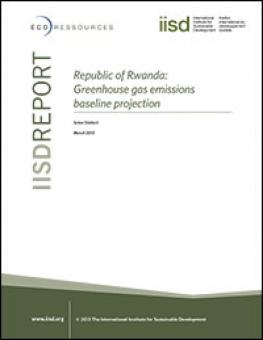
Republic of Rwanda: Greenhouse gas emissions baseline projection
Development of greenhouse gas emission baseline projections, or business-as-usual scenarios, are critical for the assessment of nationally appropriate mitigation actions.
These projections must be based on plausible and consistent assumptions on how different economic sectors might evolve in the absence of new policies and regulations directed at achieving greenhouse gas emission reductions.
Policy-makers can use the baseline projections to help evaluate appropriate technologies and practices to mitigate climate change and contribute to national development objectives. The main purpose of the baseline is to have a projection against which to evaluate mitigation policies and measures, but the baseline also provides a starting point to consider alternative scenarios and forecast emissions, and to measure progress towards possible targets. In addition, the process of developing baseline projections provides an independent review of the assumptions and data used to develop national emission inventories and can lead to more robust and accurate emission inventories.
In this report, a single emissions baseline projection for the Republic of Rwanda is generated out to 2030. It represents a conservative estimate of future emissions and considers existing climate policies and regulations. This forms the reference baseline—or business-as-usual scenario—against which it is possible to demonstrate the abatement potential of low-carbon development options. Specific methodologies, data and assumptions are presented for the seven sectors that align with United Nations Framework Convention for Climate Change guidelines: energy demand, energy supply, transportation, industrial processes, agriculture, land use, land-use change and forestry and waste. Recommendations are also made for the improvement of emission inventories.
Participating experts
You might also be interested in
G20 Finance Ministerials and World Bank/IMF Spring Meetings: Expert comment
G20 finance ministerials and World Bank/IMF spring meetings will take place this week in Washington. High on the agenda is the need to mobilize trillions of dollars of investment in the transition to clean energy.
IISD Applauds Canada’s Reaffirmation to End Domestic Public Finance for Fossil Fuels in Budget 2024
Today's federal budget announcement delivers new measures to support affordability and reaffirms Canada’s commitments on climate action.
South African Fossil Fuel Subsidies Hit Record Highs as Country's Energy Crisis Deepens
South Africa's fossil fuel subsidies tripled between 2018 and 2023, hitting USD 7.5 billion, up from USD 2.9 billion 5 years earlier, a new report by IISD reveals.
Blackouts and Backsliding: Energy subsidies in South Africa 2023
Blackouts and Backsliding presents the latest energy subsidy data for South Africa.